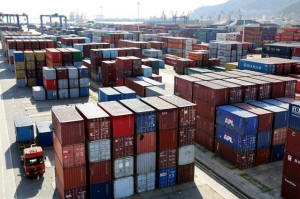|
China September exports surge, creating
record surplus with U.S. despite tariffs
 Send a link to a friend
Send a link to a friend
 [October 12, 2018]
By Elias Glenn and Stella Qiu [October 12, 2018]
By Elias Glenn and Stella Qiu
BEIJING (Reuters) - China's vast export
engine unexpectedly kicked into higher gear in September, producing a
record trade surplus with the United States that could exacerbate the
already-heated dispute between Beijing and Washington.
Analysts said last month's strong export growth - which might indicate
U.S. tariffs are not biting much yet - is unlikely to be sustained.
But the robust numbers reported on Friday by China's customs agency -
the last ones from China before U.S. congressional elections on Nov. 6 -
could prompt a reaction from U.S. President Donald Trump.
September exports rose 14.5 percent from a year earlier, the fastest
pace since February, the customs data showed. That was well above
August's 9.8 percent and a Reuters poll forecast of 8.9 percent.
"The big picture is the Chinese exports have so far held up well in the
face of escalating trade tensions and cooling global growth, most likely
thanks to the competitiveness boost provided by a weaker renminbi," said
Julian Evans-Pritchard, senior China economist at Capital Economics.
"With global growth likely to cool further in the coming quarters and US
tariffs set to become more punishing, the recent resilience of exports
is unlikely to be sustained."

YUAN DEPRECIATION
A weaker yuan <CNY=CFXS>, which has depreciated about 6 percent against
the dollar this year, may have taken the sting out of the tariffs
imposed on $250 billion of exports to the United States.
Despite concerns from some officials about the yuan's depreciation, U.S.
Treasury staff have not recommended labeling China as a currency
manipulator in a coming report on foreign exchange rate practices,
according to media reports on Thursday.
China's politically-sensitive surplus with the U.S. was $34.13 billion
in September, surpassing the record of $31.05 billion in August.
Beijing's export data has been surprisingly resilient to tariffs,
possibly because companies ramped up shipments before broader and
stiffer U.S. duties went into effect, raising concerns about a sharper
drop in export strength once all tariffs kick in.
"The front-loading impact is quite obvious to me," said Betty Wang,
senior China economist at ANZ in Hong Kong.
She cited a jump in exports of electrical machinery - the biggest export
item from China to the U.S. - as a sign exporters might have pushed out
shipments ahead of implementation of the latest tariffs on $200 billion
in Chinese exports.
'FURTHER DOWNSIDE RISK'
Along with electrical machinery, exports for textiles, furniture and
chips all rose faster than in the previous month, the customs data
showed.
"If thatís the case then I think further downside risk can be expected
in the fourth quarter," Wang said.
Li Kuiwen, a spokesman from the country's customs agency, also told
reporters trade growth may slow somewhat in the fourth quarter.

The world's two biggest economies last slapped tit-for-tat tariffs on
each other's goods on Sept. 24. There is no specific date set for the
next round of tariffs, even as Trump has made repeated threats to impose
them on virtually all Chinese goods.
[to top of second column]
|

Shipping containers are seen at a port in Lianyungang, Jiangsu
province, China September 8, 2018. REUTERS/Stringer

China's exports to the U.S. continued to rise at a double- digit
clip in September compared with a year earlier, while imports fell
for the first time since February.
Over the first nine months of the year, China's surplus with its
largest export market totaled $225.79 billion, compared with about
$196.01 billion in the same period last year.
Growth in overall imports for September instead showed a moderate
slowdown, in line with signs the broad cooling in domestic demand.
Imports rose 14.3 percent in September, versus a 19.9 percent gain
in August, slightly missing analysts' forecast of a 15.0 percent
growth.
Iron ore imports rose to their highest level in four months as steel
mills ramped up output ahead of winter production restrictions.
FEELING HEAT
For trade with all countries, China logged a surplus of $31.69
billion for September, compared with forecasts in a Reuters poll for
$19.4 billion and August's surplus of $27.89 billion.
China's economy is feeling some heat from tariff dispute and signs
of slowing that prompted the central bank on Sunday to loosen policy
by cutting banks' reserve requirement ratio (RRR) for a fourth time
this year.
Growth in China's factory sector in September stalled after 15
months of expansion, with export orders falling the most in more
than two years, a private business survey showed. An official survey
also confirmed a further manufacturing weakening.

To shore up growth, Beijing has pledged to increase export tax
rebates from Nov. 1 for the second time this year and promised to
cut corporate burden on a larger scale to help struggling Chinese
firms.
The International Monetary Fund on Tuesday cut its global economic
growth forecasts for this year and next, saying that the U.S-China
trade war was taking a toll. It also slashed China's growth forecast
for next year to 6.2 percent from 6.4 percent.
China will cut import tariffs on a wide range of goods beginning on
Nov. 1, as part of Beijing's pledge to take steps to increase
imports this year amid rising tension.
(Reporting by Elias Glenn and Stella Qiu; Additional reporting by
Lusha Zhang; Editing by Richard Borsuk)
[© 2018 Thomson Reuters. All rights
reserved.]
Copyright 2018 Reuters. All rights reserved. This material may not be published,
broadcast, rewritten or redistributed.
Thompson Reuters is solely responsible for this content. |